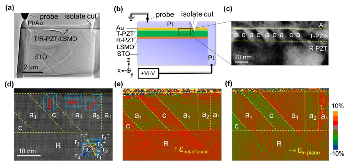Deterministic Ferroelastic Domain Switching Using Ferroelectric Bilayers
- Brookhaven National Lab. (BNL), Upton, NY (United States). Condensed Matter Physics and Materials Science Dept.; Univ. of New South Wales, Sydney, NSW (Australia). School of Materials Science and Engineering
- Brookhaven National Lab. (BNL), Upton, NY (United States). Condensed Matter Physics and Materials Science Dept.
- Pennsylvania State Univ., University Park, PA (United States). Dept. of Materials Science and Engineering
- Univ. of New South Wales, Sydney, NSW (Australia). School of Materials Science and Engineering
Composition gradients, or dissimilar ferroelectric bilayers, demonstrate colossal electromechanical figures of merit attributed to the motion of ferroelastic domain walls. Yet, mechanistic understanding of polarization switching pathways that drive ferroelastic switching in these systems remains elusive. Here, the crucial roles of strain and electrostatic boundary conditions in ferroelectric bilayer systems are revealed, which underpin their ferroelastic switching dynamics. Using in situ electrical biasing in the transmission electron microscope (TEM), the motion of ferroelastic domain walls is investigated in a tetragonal (T) Pb(Zr,Ti)O3 (PZT)/rhombohedral (R) PZT epitaxial bilayer system. Atomic resolution electron microscopy, in tandem with phase field simulations, indicates that ferroelastic switching is triggered by predominant nucleation at the triple domain junctions located at the interface between the T/R layers. Furthermore, this interfacial nucleation leads to systematic reversable reorientation of ferroelastic domain walls. Finally, deterministic ferroelastic domain switching, driven by the interfacial strain and electrostatic boundary conditions in the ferroelectric bilayer, provides a viable pathway toward novel design of miniaturized energy-efficient electromechanical devices.
- Research Organization:
- Brookhaven National Lab. (BNL), Upton, NY (United States)
- Sponsoring Organization:
- USDOE Office of Science (SC), Basic Energy Sciences (BES)
- Grant/Contract Number:
- SC0012704
- OSTI ID:
- 1566820
- Report Number(s):
- BNL-212108-2019-JAAM
- Journal Information:
- Nano Letters, Vol. 19, Issue 8; ISSN 1530-6984
- Publisher:
- American Chemical SocietyCopyright Statement
- Country of Publication:
- United States
- Language:
- English
Web of Science
Similar Records
Extrinsic contributions to the response in ferroelectric ceramics
In-situ structural investigations of ferroelasticity in soft and hard rhombohedral and tetragonal PZT



